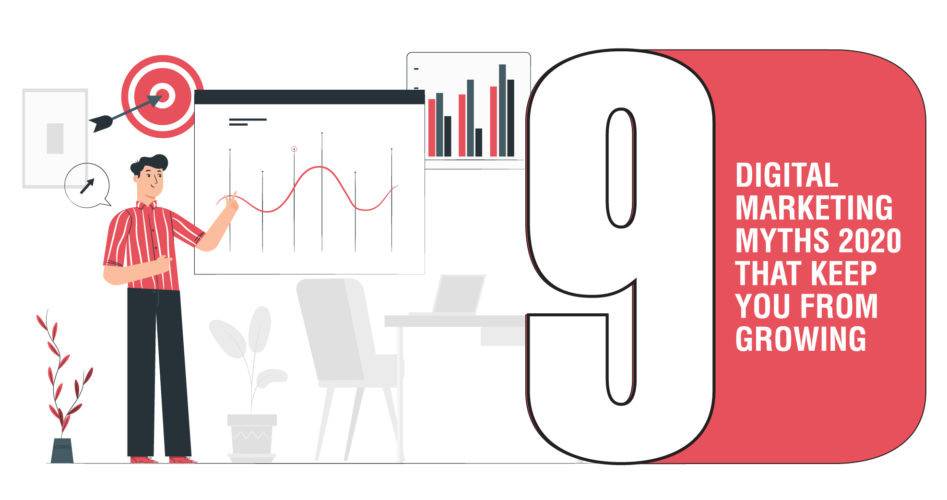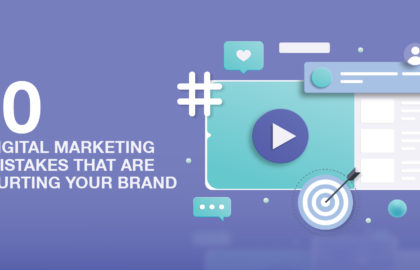Do you stay up at night wondering how you can make your business grow? Do you find yourself obsessing over which platforms are best when it comes to advertising your brand? If you are, then you’ve come to the right place.
Navigating the digital space can be confusing. But fret not, we’re here to help you out. Here are nine digital marketing myths in 2020 that you need to be wary of when putting your business out there:
Myth 1: You just need digital marketing
We can’t contend the fact that marketplaces are slowly transforming into marketspaces and that we live in an era when business deals are made over WhatsApp messages. While most customers can be found on the Internet –– and engaging them is of utmost importance –– focusing your marketing efforts only on the digital front is not the answer.
Any marketer will tell you that a balance of traditional and digital marketing is the way to go. Clearly outline your end-goal and implement a strategy that incorporates a healthy mix of online and on-ground efforts –– like they say, never put all your eggs in one basket.
Myth 2: Your customers aren’t present on a digital platform
Just because your TG is not the millennial consumer, doesn’t mean that your brand needn’t have an online presence. The assumption that the elderly do not engage with the digital space is simply false. According to a study conducted by the Pew Research Center, about 80% of people between the age group of 30-49 use social media and about 37% of people above the age of 65 are familiar with and use platforms like Facebook and YouTube.
It’s also important to know that digital marketing is not restricted to social media. It includes email marketing; a recent study shows that 9 out of 10 people above the age of 45 still use this medium. Knowing your TG and the multiple touchpoints you can interact with them on, are key things to consider while working on any digital marketing plan.
Myth 3: SEO is a one-and-done process
Let’s face it. For everything you say, there are ten more things being said — this is the reality of the Internet age. There’s a lot of information out there and making your content stand out can be a challenge. This is where SEO comes into play; it’s the magic wand that boosts your visibility on search engines.
However, braving the SEO landscape is not a one-time ritual. Google’s algorithms change every year. And your website will need to be optimized accordingly, in a timely manner. So plan your budgets ahead of time and get the best results.
Myth 4 – You don’t need to keep updating your content strategy
Think of your brand as a person with a distinctive voice, manner of speaking, and unique characteristics. Saying the same things again and again, in the same manner, is bound to get boring. The star at the party is always the one with the newest and most exciting stories.
Like human beings, your brand too needs to constantly find new ways to get your message across. What you say, when you say it, and how you put it across has a big effect on how your consumers relate to you.
The trick, then, is to keep revising your content strategy on a regular basis. Recognize the online conversation and find new ways to contribute to it. And soon your brand will be the hottest thing out there.
Myth 5 – You’ve got to use time-tested marketing strategies
Playing it safe is a good thing. But when you stick to what works and don’t experiment with new ideas, you stagnate. You probably won’t lose any business, but you won’t grow either. As they say, fear of failure stops you from becoming the best version of yourself and Darwinian laws attest to this as well.
While it’s important to follow trends, it’s also essential to set aside a budget for quirky, out-of-the-box ideas. As long as you know what your brand stands for, go ahead and take a chance at something new. Trust us, some of the most successful campaigns are also some of the most peculiar ones.
Myth 6 – You can’t track results on the digital marketing front
Not all of us are born with analytical minds and thankfully, not all of us need to be. Platforms like Google Analytics and SEMRush are good places to analyze marketing plans and digital spends — all geared to make your life online simpler.
Studying your page views, bounce rate, and the average time spent on your website will give you a fair idea of how well your website is engaging your customers. You can then choose to make adjustments to your plan and experiment with new ideas. Yes, this can be daunting at first, but the more time you spend doing this, the better and easier it gets. Remember, there’s no secret sauce to success. It’s all about finding your sweet spot.
Myth 7 – Negative comments are not good for business
Think of a situation where your boss or colleague has something negative to say about you. You can either choose to take that as constructive feedback or you can choose to go on the defensive and ignore them. The former will definitely guarantee growth — both personal and professional, while the latter will just drag you down.
Negative feedback on social media is very similar. Addressing the feedback in a polite manner will not only convert a disgruntled customer to a loyal one but will also give key insight into what your customers expect from you. The secret lies in how you deal with the situation.
Myth 8: Digital marketing bears instant result
Any marketing initiative, whether digital or traditional, takes time to materialize. It is only human that your customers take time to trust you and understand you as a brand. So no matter how great your website or your social media strategy, it takes time to generate brand awareness and engagement.
Even after a potential customer has engaged with your brand, there’s no guarantee that they will convert and buy your product. So wait it out, let engagement happen organically. Your brand will slowly gain the traction it deserves, converting to profits along the way. All it takes is patience and perseverance.
Myth 9: Your social media strategy has to be same across platforms
Different social media platforms were created to serve different purposes. While Instagram might be a place where visually-appealing content performs well, YouTube is a channel where the video is the star. So a one-shoe-fits-all strategy is bound to backfire.
Figure out which platforms are relevant for your business and focus your efforts on creating content that works well on those specific platforms. With the right strategy, there’s nothing stopping you from growing your business.







